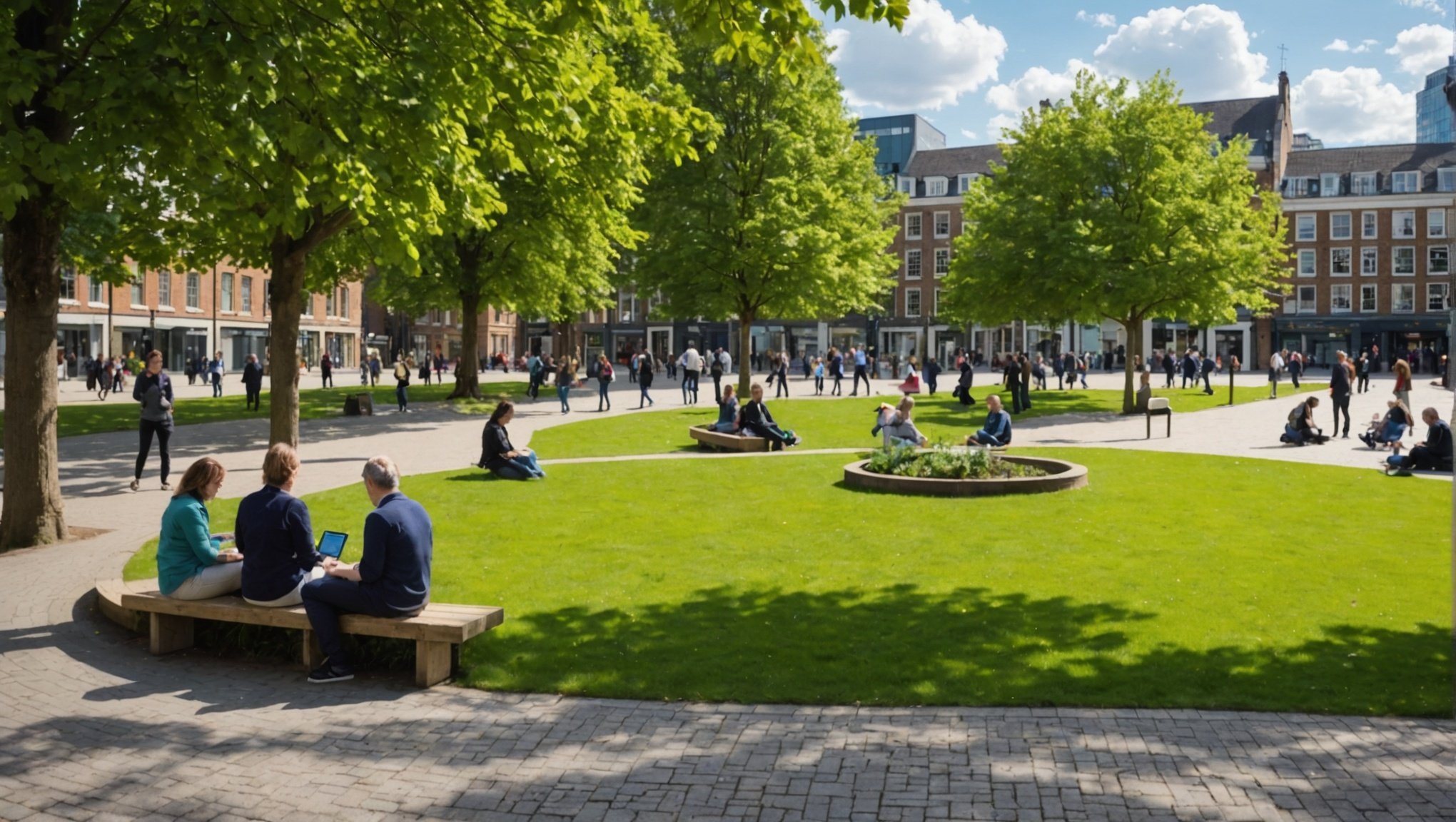Understanding the Concept of a Community-Centric Smart City Park
Community-centric parks lie at the heart of smart city design, offering spaces where technological innovation and community needs intersect. These parks are thoughtfully constructed to enhance the urban experience, prioritising civic engagement and the well-being of residents.
Integrating technology into park design brings forward numerous benefits. By harnessing advanced systems such as smart lighting, real-time environmental monitoring, and digital kiosks, cities can create safer and more accessible recreational areas. This approach not only optimises the sustainability of urban environments but also reduces maintenance costs through efficient resource management.
Additional reading : Experience luxury real estate with barnes mauritius
Moreover, the role of well-being cannot be overstated in community-centric parks. These parks provide green spaces that encourage physical activities, stress reduction, and social interactions, promoting overall mental and physical health. Designed with inclusivity in mind, they cater to diverse age groups and abilities, offering varied amenities to ensure everyone feels welcomed.
Community-centric parks exemplify the vision of a smart city, where urban environments are not just about technology but fostering a sense of belonging and connection among the residents. By focusing on community-friendly amenities and sustainable practices, these parks contribute significantly to the quality of urban living, reinforcing the notion that smart cities are about people first.
In the same genre : Crafting a Robust Cybersecurity Framework for Public Sector Entities in the UK
Key Design Principles for Smart City Parks
Designing smart city parks involves thoughtful park design principles and effective urban space planning to ensure they cater to the needs of varying groups. An inclusive design approach plays a critical role here, allowing diverse populations to enjoy these spaces. This includes accommodating people of all ages and abilities, thereby promoting a sense of belonging and community well-being.
One of the strategies to achieve this is by maximizing green space accessibility. This involves creating clear pathways for walking, cycling paths, and ensuring seamless wheelchair access. The integration of easily navigable routes not only enhances usability but also increases the footfall, making parks more vibrant and safer.
Furthermore, incorporating flexible spaces can significantly enhance the functionality of urban parks. These are areas that can be adapted for multiple uses, such as sports, picnics, or cultural events. Such adaptability encourages community activities, fostering social interaction and making parks a central hub for local life.
Inclusion, accessibility, and flexibility—these are not just basic principles but are essential to making smart city parks truly effective urban sanctuaries that offer community value. By considering these elements, urban planners can create spaces that remain relevant and beneficial to the community over time.
Technological Innovations Enhancing Parks
The integration of smart park technologies is revolutionising public green spaces, offering enhanced safety, improved energy efficiency, and sustainable management.
Smart Lighting Systems
Smart lighting systems employ sensors and connectivity to adjust illumination in real-time, optimising energy usage and safety. By using the Internet of Things (IoT in parks), these systems can detect movement, increasing brightness when necessary for security, and dimming when areas are unoccupied to save energy. Such innovations make parks more accessible during evening hours while maintaining environmental responsibility.
Interactive Digital Signage
Interactive digital signage transforms how visitors engage with park information. These displays provide dynamic content such as maps, event schedules, and educational material about local ecology, enhancing visitor experience and engagement. By using IoT technology, digital signage can be updated remotely, ensuring information is always current and relevant, fostering a rich, informative encounter for park-goers.
Eco-friendly Monitoring Systems
Emphasising sustainability, eco-friendly monitoring systems utilise smart technologies to track and manage the park’s environmental impact. These systems can monitor air quality, water usage, and biodiversity, providing real-time data that helps in making informed decisions for park management. Smart solutions focus on fostering an eco-conscious environment, promoting long-term sustainability. The integration of these technologies is crucial for evolving public spaces into intelligent, responsive venues that cater effectively to community needs.
Case Studies of Successful Community-Centric Parks
Across the UK, several successful park examples have emerged as models of excellence in urban planning. These parks have not only provided lush green spaces but have also fostered community engagement and well-being. A prime example is London’s Olympic Park. Transformed from an industrial wasteland, it now features a variety of landscapes, incorporating recreational areas and sustainability-focused initiatives.
Another noteworthy park is the Cow Tower Park in Norwich. Best practices in urban planning have been meticulously employed here, with design elements emphasizing accessibility and inclusivity. The park’s trails are designed to accommodate diverse user needs, ensuring that children, the elderly, and those with disabilities can all enjoy its facilities.
Community feedback from these projects has been overwhelmingly positive. Local residents frequently note the increased sense of community, improved mental health, and more active lifestyles as key outcomes of these developments. These outcomes highlight a critical aspect: successful parks are not just about greenery but are integral to urban life.
From these pioneering projects, urban planners have learned essential lessons for future developments. Key among these is the importance of community involvement from the outset. Engaging residents in the planning process ensures the park meets their needs, making them active participants rather than passive recipients of planning outcomes.
Involving Stakeholders in the Planning Process
Stakeholder engagement is a fundamental part of any successful planning process. It ensures that the needs and perspectives of the community are understood and integrated effectively. Community involvement can be achieved through various techniques which foster open dialogue and collaboration.
One effective method is to incorporate feedback gathering through surveys. This approach provides a structured way to understand stakeholder perspectives. Surveys can be distributed both digitally and in-person, allowing for broad participation. Workshops, on the other hand, offer an interactive platform for stakeholders to discuss ideas and share their visions. This helps in cultivating a sense of ownership and investment in the planning outcomes.
Building partnerships with local organizations is another key strategy. These entities often have established relationships and trust within the community, which can be leveraged to enhance stakeholder engagement. By working together, planners can access valuable insights and resources that local organizations offer, leading to more informed and comprehensive planning processes.
Incorporating these techniques not only enriches the planning with diverse inputs but also increases the likelihood of successful implementation. By actively engaging stakeholders, projects can benefit from collective wisdom and support, crucial for achieving long-term success.
Benefits of Community-Centric Smart Parks
Incorporating community benefits into the framework of smart parks significantly enhances both physical and mental well-being for residents. These parks provide green spaces that invite activities like jogging, yoga, and leisurely walks. Such interactions with nature not only boost physical health but also reduce stress levels and improve mental health. Urban parks serve as oases of calm in bustling cities, giving people essential breathing space.
The design of community-centric parks fosters social inclusion and cohesion, creating environments where people from different walks of life can connect. These parks often feature community gardens, playgrounds, and communal seating areas which naturally bring individuals together. This setup encourages communication, understanding, and friendships among neighbours. By promoting social engagement, these parks become powerful tools in building a more cohesive and harmonious community.
These parks contribute significantly to environmental sustainability and biodiversity. Smart technologies integrated into park design, such as energy-efficient lighting and smart irrigation systems, reduce resource consumption. Meanwhile, maintaining diverse plant species within parks ensures a thriving local ecosystem, attracting various birds and insects. This biodiversity supports environmental health and helps educate the community on ecological conservation. Smart parks, thus, play a crucial role in fostering a sustainable and vibrant urban landscape.











